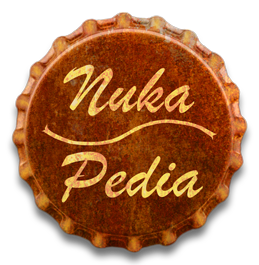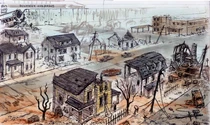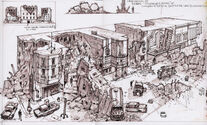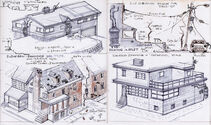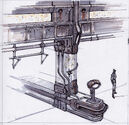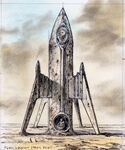Paladin117 (talk | contribs) m (Edited links.) |
Jspoelstra (talk | contribs) No edit summary |
||
| Line 17: | Line 17: | ||
The nuclear holocaust drove many of Bethesda's residents into a savage tribe of raiders; living, breeding and hunting in the ruins of Bethesda. Olney became Old Olney; which some still resided, but right after the war the surrounding countryside made gathering supplies for support difficult, so many moved away. Since then, the ruins became all but a large deathclaw breeding ground. Annandale has become Andale, a town of inbred cannibals. Arlington is nothing more than [[Mama Dolce's]] and the national cemetery surrounded by pockets of open ground only accessible by the metro tunnel. Springvale is a burnt down looted pre-War town. Germantown has become a home for [[Vault 87 super mutant|super mutants]] that use the area to capture locals in order to increase their numbers. |
The nuclear holocaust drove many of Bethesda's residents into a savage tribe of raiders; living, breeding and hunting in the ruins of Bethesda. Olney became Old Olney; which some still resided, but right after the war the surrounding countryside made gathering supplies for support difficult, so many moved away. Since then, the ruins became all but a large deathclaw breeding ground. Annandale has become Andale, a town of inbred cannibals. Arlington is nothing more than [[Mama Dolce's]] and the national cemetery surrounded by pockets of open ground only accessible by the metro tunnel. Springvale is a burnt down looted pre-War town. Germantown has become a home for [[Vault 87 super mutant|super mutants]] that use the area to capture locals in order to increase their numbers. |
||
| − | Many historic landmarks of the former [[United States of America]] such as the [[Capitol Building]], the [[Museum of Technology]], the [[Museum of History|Museum of American History]], and the [[The Mall|National Mall]] are now super mutant infested ruins or, like the [[White House]], just radioactive craters. However, new towns such as [[Megaton]], [[Rivet City]], [[Tenpenny Tower]], [[Underworld]], and [[Little Lamplight]], as well as smaller settlements: the [[Republic of Dave]], [[Oasis]], [[Big Town]], [[Arefu]], Andale, the [[Temple of the Union]], [[Canterbury Commons]], and [[Girdershade]] have since risen out of the ashes of war. The people of the Wasteland barely have enough supplies to scratch out a living, seeing as the only agriculture being mutfruit and lab grown plants, such as potatoes and carrots. The towns mainly survive off of brahmin meat, milk, and squirrel and iguanas. Hunters also provide the locals with meat from various other parts of the Wasteland, and a small amount of fish from the Potomac river. Also, a large amount of food comes from scavengers inside the DC area who scavenge pre-War food. Food is traded between the Capital Wasteland and [[Point Lookout]], Maryland where many merchants in the wasteland can be found to have [[punga fruit]], which is only native to the swamplands of Point Lookout. [[Tobar|Tobar the Ferryman]] used to trade this fruit with the local merchants. |
+ | Many historic landmarks of the former [[United States of America]] such as the [[Capitol Building]], the [[Museum of Technology]], the [[Museum of History|Museum of American History]], and the [[The Mall|National Mall]] are now super mutant infested ruins or, like the [[White House]], just radioactive craters. However, new towns such as [[Megaton]], [[Rivet City]], [[Tenpenny Tower]], [[Underworld]], and [[Little Lamplight]], as well as smaller settlements: the [[Republic of Dave]], [[Oasis]], [[Big Town]], [[Arefu]], Andale, the [[Temple of the Union]], [[Canterbury Commons]], and [[Girdershade]] have since risen out of the ashes of war. The people of the Wasteland barely have enough supplies to scratch out a living, seeing as the only agriculture being mutfruit and lab grown plants, such as potatoes and carrots. The towns mainly survive off of brahmin meat, milk, and squirrel and iguanas. Hunters also provide the locals with meat from various other parts of the Wasteland, and a small amount of fish from the Potomac river. Also, a large amount of food comes from scavengers inside the DC area who scavenge pre-War food. Food is traded between the Capital Wasteland and [[Point Lookout (location)|Point Lookout]], Maryland where many merchants in the wasteland can be found to have [[punga fruit]], which is only native to the swamplands of Point Lookout. [[Tobar|Tobar the Ferryman]] used to trade this fruit with the local merchants. |
The most influential [[Fallout 3 factions|factions]] of the region include the [[Brotherhood of Steel (Capital Wasteland)|East Coast Brotherhood of Steel]], with their base camp located in the [[Citadel]], built into and beneath the ruins of the Pentagon, the [[Enclave]], who secluded themselves in [[Raven Rock]], and a lot of people believe that their radio broadcast is just a pre-recorded pre-War tape stuck on a loop. Super mutants, emerging from [[Vault 87]], that overrun most of the Downtown DC and Arlington areas, as well as much of the wasteland. [[Slavers]], operating from [[Paradise Falls]], [[Brotherhood Outcasts]] of [[Fort Independence]] who left the B.O.S. to continue what they believe to be their mission, the [[Talon Company]] mercenaries, base at the ruins of Fort Bannister, and various [[Raiders (Fallout 3)|raider]] tribes, who have numerous small camps and nomadic tribes in the area, the largest being [[Evergreen Mills]]. |
The most influential [[Fallout 3 factions|factions]] of the region include the [[Brotherhood of Steel (Capital Wasteland)|East Coast Brotherhood of Steel]], with their base camp located in the [[Citadel]], built into and beneath the ruins of the Pentagon, the [[Enclave]], who secluded themselves in [[Raven Rock]], and a lot of people believe that their radio broadcast is just a pre-recorded pre-War tape stuck on a loop. Super mutants, emerging from [[Vault 87]], that overrun most of the Downtown DC and Arlington areas, as well as much of the wasteland. [[Slavers]], operating from [[Paradise Falls]], [[Brotherhood Outcasts]] of [[Fort Independence]] who left the B.O.S. to continue what they believe to be their mission, the [[Talon Company]] mercenaries, base at the ruins of Fort Bannister, and various [[Raiders (Fallout 3)|raider]] tribes, who have numerous small camps and nomadic tribes in the area, the largest being [[Evergreen Mills]]. |
||
Revision as of 17:53, 8 August 2012
Fallout 3 locations project
This article is within the scope of the Fallout 3 locations project. This project is dedicated to standardizing Fallout 3 location articles. For participation, please check the project page.
|
The Capital Wasteland is the general name given to the ruins of Washington, D.C. and the region surrounding it. It stretches from Raven Rock in the northwest to Rivet City in the southeast, with what's left of the Potomac River dividing it roughly in two. It serves as the game-world for Fallout 3.
Background
Before the Great War, the Capital Wasteland was part of the Columbia Commonwealth and contained the District of Columbia as well as the major cities of Arlington, Annandale, Bethesda, Springvale, Germantown, Fairfax, Alexandria and Olney. During the events of 2077, the city of Washington, D.C. was hit by a bombardment of nuclear weapons that completely destroyed the city and irradiated the surrounding area. Being the Capital, it was hit harder than most of the country. By comparison to the west coast, the D.C. area is mostly rubble and ruins. Only a few buildings, mostly landmarks due to their more precise building techniques used, remain in the area. The primary method of getting around downtown D.C. is the Metro system, due to the roads and streets literally being blocked completely by towering walls of rubble. However, the Virginia area of the Wasteland is more open due to the fact that there were fewer buildings there in the first place. Therefore, there isn't much rubble and is much easier to traverse.
Some missiles in this bombardment also targeted nearby Fort Bannister. Not only did the fort suffer a nearly direct hit, the bombs also decimated the surrounding countryside. As of 2277, the area is naught but a lifeless and barren desert, with the western edge of the Wasteland containing large craters filled with radiation. Some stray bombs fell off course and hit the countryside, though not doing much damage but still irradiating the surrounding areas.
The nuclear holocaust drove many of Bethesda's residents into a savage tribe of raiders; living, breeding and hunting in the ruins of Bethesda. Olney became Old Olney; which some still resided, but right after the war the surrounding countryside made gathering supplies for support difficult, so many moved away. Since then, the ruins became all but a large deathclaw breeding ground. Annandale has become Andale, a town of inbred cannibals. Arlington is nothing more than Mama Dolce's and the national cemetery surrounded by pockets of open ground only accessible by the metro tunnel. Springvale is a burnt down looted pre-War town. Germantown has become a home for super mutants that use the area to capture locals in order to increase their numbers.
Many historic landmarks of the former United States of America such as the Capitol Building, the Museum of Technology, the Museum of American History, and the National Mall are now super mutant infested ruins or, like the White House, just radioactive craters. However, new towns such as Megaton, Rivet City, Tenpenny Tower, Underworld, and Little Lamplight, as well as smaller settlements: the Republic of Dave, Oasis, Big Town, Arefu, Andale, the Temple of the Union, Canterbury Commons, and Girdershade have since risen out of the ashes of war. The people of the Wasteland barely have enough supplies to scratch out a living, seeing as the only agriculture being mutfruit and lab grown plants, such as potatoes and carrots. The towns mainly survive off of brahmin meat, milk, and squirrel and iguanas. Hunters also provide the locals with meat from various other parts of the Wasteland, and a small amount of fish from the Potomac river. Also, a large amount of food comes from scavengers inside the DC area who scavenge pre-War food. Food is traded between the Capital Wasteland and Point Lookout, Maryland where many merchants in the wasteland can be found to have punga fruit, which is only native to the swamplands of Point Lookout. Tobar the Ferryman used to trade this fruit with the local merchants.
The most influential factions of the region include the East Coast Brotherhood of Steel, with their base camp located in the Citadel, built into and beneath the ruins of the Pentagon, the Enclave, who secluded themselves in Raven Rock, and a lot of people believe that their radio broadcast is just a pre-recorded pre-War tape stuck on a loop. Super mutants, emerging from Vault 87, that overrun most of the Downtown DC and Arlington areas, as well as much of the wasteland. Slavers, operating from Paradise Falls, Brotherhood Outcasts of Fort Independence who left the B.O.S. to continue what they believe to be their mission, the Talon Company mercenaries, base at the ruins of Fort Bannister, and various raider tribes, who have numerous small camps and nomadic tribes in the area, the largest being Evergreen Mills.
Environment
The D.C. area was hit more severely than the west coast, due to its military and political areas along with the fact it lacked a defense system against nuclear attacks.
As a result, the local inhabitants are far more hostile and only are friendly to members of their group as in the many raider tribes. Pockets of radiation are far more frequent and in higher concentrations. Purified water is extremely scarce as well as any kind of fresh food. There is little flora with dead husks of trees that had been alive before the Great War.
The buildings in the D.C. ruins have been hit the hardest structurally as most are either completely destroyed, are falling apart, literally falling into each other or just barely standing. The streets are littered with rubble and are largely impassible, forcing explorers to mainly rely on sewers and subways to navigate the city, most of which have caved in.
Any functional buildings are either a constant war-zone or are heavily fortified by a group of wastelanders, mostly in the southeast section of the Wasteland. Most of the northern and southern parts of the Wasteland are far more inhabitable but don't have enough pre-War resources to support many people. Thus, only hermits, raiders, and wastelander families still inhabit these desolate areas.
There is never any form of precipitation.
Inhabitants
The Capital Wasteland is a nearly inhospitable and violent area. It is not uncommon to find dead bodies that have been victims of raiders or desperate wastelanders. Few materials that are encountered are freshly manufactured in any way and scavenging or trading is the only reliable mean of finding materials to survive. Traders are typically found all over the wasteland and sell their wares to travelers, most commonly in the D.C. ruins and metro tunnels. Mutated creatures such as centaurs are much more common in the Capital Wasteland than in the Core Region.
Slavery is a common occurrence as it is fairly easy, pays large amounts of caps (which are the standardized currency in the area), slaves are always needed and is an easy way for someone to quickly gain powerful weapons. Groups of marauders called raiders attack unsuspecting or weak travelers using tactics similar to guerrilla warfare. The raiders take pride in strength, attack anyone who is weak, and their favorite activities of torture and killing.
The old world is still prevalent beyond the bombed out building and radiation. Ghouls are fairly common, partly due to the large pockets of radiation, irradiated food, and the large population of people during the Great War. Ghouls, although having better knowledge of the terrain and its technology that has survived, have become the points of ridicule among the various denizens, to the point where one could easily see similarities to racism.
Murder is a common occurrence as well, with the pre-War laws having been long neglected and forgotten. Either because a person needs to kill another in order to get a precious scrap of food or water, to show a power of dominance or just simply because they don't care about other people's lives (examples: Mr. Burke, Eulogy Jones, etc.).
Few water based organisms are still alive due to radiated water besides mirelurks, which inhabit whats left of the Potomac River. Mirelurks usually can be found in dark, damp, and radiated areas, especially the Nuka-Cola Plant. Some Mirelurks have expanded as far as to Point Lookout.
Super mutants are far more common in the DC area then in the west and, as there is little in the way of an effective military, a person must either have extreme luck, be heavily armed or hope they run into a Brotherhood of Steel patrol in order to survive an encounter with a super mutant.
Drug use is still a common occurrence in the Capital Wasteland. In fact, they're one of the few things that are being freshly produced along with medicinal drugs for medical needs though they are pretty expensive.
Though not all hope is lost for the Capital wasteland.
Not all residents of the Capital Wasteland are violent. In fact, there are a fair number of settlements with a population of civil (although sometimes unsavory) people (examples: Megaton, Rivet City, Tenpenny Tower).
Some of the inhabitants even try to keep some form of order in the Capital Wasteland. The Regulators seek out criminals and kill them. The Temple of the Union tries to help runaway slaves. The East Coast Brotherhood of Steel contains a large portion of the super mutant threat with regular patrols in the DC ruin.
Beyond drugs, people are trying to manufacture new goods, grow food and even have their own version of "wasteland recycling". Rivet City is currently the only producer of non-irradiated food and is working on portable fusion power. Point Lookout has also proven to be a reliable source of supply, especially its punga fruit. Motorcycles are being turned into sets of metal armor. Weapons, such as the Shishkebab and railway rifle, are being made out of materials originally thought to be junk.
Vegetation
- Moss: In Oasis, much of the ground is covered in moss.
- Flowers: The majority of the flowers found in the Capital Wasteland are in human dwellings and are mostly just for decoration. However, in the Arlington Cemetery, there are three healthy flowers poking out of the soil. There is also a flowering plant in front of a grave stone in a cemetery to the north of Mama Dolce's. It is purple and white and appears perfectly healthy.
There are 3 types of flowers:
- Pansies: A cluster of 3-4 purple/white pansies with a few leaves.
- Daffodils: Long, slender leaves with 2-3 trumpet shaped yellow flowers.
- Hollyhock: A spire of pink flowers with a few leaves at the base.
Trees: Some types of trees are distinctive, with the following characteristics:
- Leafless: A trunk with a mass of leafless branches.
- Pine tree: A spire of leafless branches.
- Willow tree: Drooping, low-hanging branches.
- Mangrove tree: Lots of roots with thin trunks and a few branches.
- Grass: Most wasteland grass is a sickly brown color, but some grass further north and south in the wasteland is a bit healthier.
- Bushes: The bushes provide little cover from fighting, but they do provide concealment, making them a nuisance in V.A.T.S. as they can cause hit percentages to drop to 0%.
- Mutfruit: There are two types of mutfruit: crunchy and regular. Mutfruit looks like a blue bloated version of a raspberry, and crunchy mutfruit looks like a brown peach with some glowing red-pink patches. The only source of mutfruits is through traders and some stores, and have never been found growing in the wild.
- Fresh fruits and vegetables: The fresh fruit and vegetables of the wasteland can be found in the Arlington Public Library beside a trash can in a bathroom and in the Rivet City science lab. Dialogue with various characters throughout Rivet City reveals that they have a hydroponics lab. In which case, the scientists have been engineering pre-War plants to grow with their roots systems in purified water rather than the irradiated soil of the Wasteland.
- Wild punga fruit and regular punga fruit are grown in masses by the tribals at Point Lookout
Three variations of fungi:
- Glowing fungus: The green, glowing mushrooms that are found in the Capital Wasteland. Found in most caves, metros, sewers, and other damp, dark places. Often found at sites of radiation. The Deathclaw Sanctuary and Little Lamplight have multiple formations of this fungus. This fungus has also been seen in blue and yellow-orange.
- Brain-like fungus: A fungus that resembles a mass of brains. Found in many caves, as well as damp places, and near outcroppings of rocks in the Wasteland. The fungus shares characteristics with live tissue because, when attacked by a weapon, blood flies out.
- Cave fungus: found only in the caves of Little Lamplight. It is used extensively by the children of Little Lamplight. The fungus is believed to have grown out of the bodies of deceased adults within the caves. The fungus thrives on strange meat. The fungus soaks up radiation and replenishes lost health. It also acts as a food source for the children, but it supposedly does not taste very good. Cave fungus is eaten as a kebab.
Appearances
The Capital Wasteland only appears in Fallout 3.
Gallery
See also
Location map - This is a map which only provides locations.
